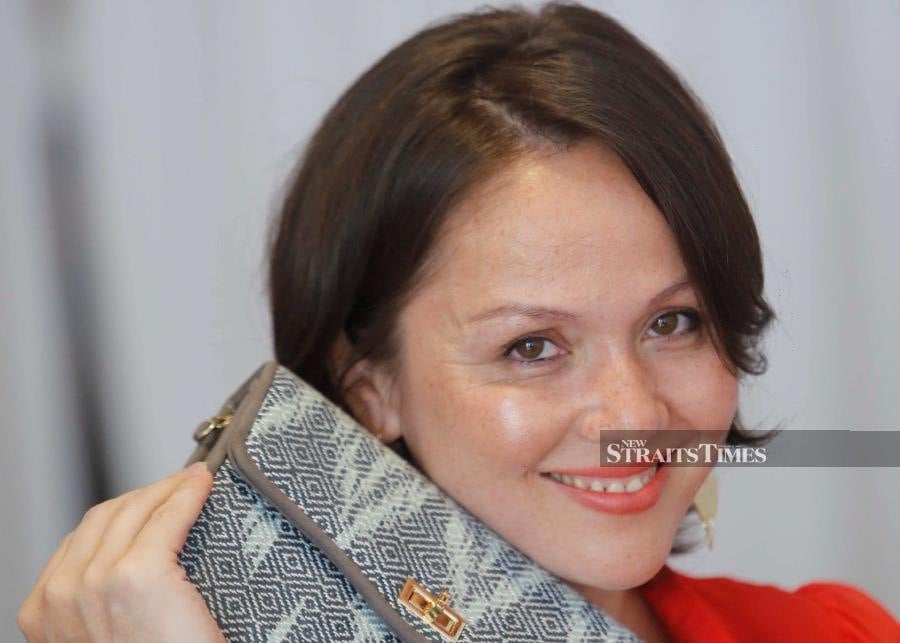Ikat is an ancient craft and one woman is doing her part to ensure that it lives on, writes Aznim Ruhana Md Yusup
IN the fabric world, ikat refers to a resist dyeing technique. It’s somewhat similar to batik, where patterns are created when colours are blocked from seeping into woven cloth using wax.
In ikat, however, the work starts with unwoven threads. Thousands of them are bundled and tied to create a particular pattern, and then dipped in dye. The tying stops the colour from seeping in and once dry, the threads are woven into cloth.
While the name ikat has Malay roots, historians aren’t quite sure where the technique comes from.
According to the book, A Common Thread: Ikat of the Islamic World, published by the Islamic Arts Museum Malaysia, ikat is a traditional practice that goes back thousands of years in parts of Asia and Latin America.
It’s called pua kumbu in Sarawak, kasuri in Japan, tiraz in Yemen and patola in India. Indigenous communities in Latin America have been making ikat long before the Spanish conquest in the 15th century, and the fabric can be found today in Mexico, Guatemala, Chile and Argentina.
There are regional differences to ikat. Some places may use cotton or silk threads, or wool in cooler climates. Colours depend on the plants for making dyes. Motifs are different too. For example, ikat-making Muslim communities shun patterns with human-like figures.
Despite these differences, ikat patterns will invariably appear blurry and distorted because of how the threads are dyed. There are usually no straight lines or repeated motifs that look exactly alike, and that is part of the charm of ikat.
CENTRAL ASIA TIES
While most ikat cloths have subdued colours, the ones from Central Asia are known for vibrant shades and bold patterns.
Fans include Francisca Turner, who’s been using ikat from Uzbekistan since she started the accessories and home furnishing label Frankitas in 2014.
“Even though I’m Indonesian ― and Indonesia makes great ikat ― the ones from Uzbekistan stand out. They are super versatile and are still made using the ancient techniques that have nine to 12 steps,” says Turner, who is based in Kuala Lumpur.
In the olden days, weavers would dream of patterns and colours before tying and dying the threads accordingly. These days, patterns are marked from an existing design but the work remains laborious and time-consuming.
“Most modern ikat cloths are woven by machines and use chemical dyes. Not in Uzbekistan. It’s all done by hand with no heavy machinery while the colours come from natural, plant-based dyes.
“Ikat is a huge part of the Uzbek heritage and the industry is a source of livelihood for many people there. But this isn’t widely known or promoted.”
Meanwhile, the Uzbekistan ambassador to Malaysia, Ravshan Usmanov, visited the Frankitas gallery in Bukit Damansara a few months ago.
This led to a meeting with Turner, where he thanked her for using and promoting his country’s heritage product.
The relationship was further enhanced when Frankitas was invited to showcase its wares at an embassy event to celebrate the republic’s 28th year of independence and there are plans to continue working with Frankitas to promote Uzbek ikat.
IKAT DISTINCTIONS
Historically, ikat weaving helped bolster the economy of cities in Uzbekistan such as Bukhara, Samarqand and Khokand when the activity was at its peak in the 19th century.
“Ikat weavers lived in close-knit communities, some belonging to guilds owned by patriarchal masters,” goes a passage from A Common Thread.
“The unsung heroes were the master dyers, responsible for the kaleidocospic effect of pattern and colour. The art of concocting dyes was a highly specialised skill, with jealously-guarded secrets passed down through the generations.”
This heritage continues today.
According to Turner, young Uzbeks are very much involved in making ikat, which shows that it is a viable way to make a living. Consider this against Malaysia’s traditional crafts where there is a lack of youth workers who, perhaps understandably, prefer other jobs that are easier and more lucrative.
In addition to ikat from Uzbekistan, Turner uses ikat from Cambodia and Indonesia to make her bags.
It’s easy to tell where the fabric comes from once you know what you are looking for ― Uzbek ikat is richly hued and made of silk while Cambodian ikat, woven from wool threads, has a more understated palette.
Rangrang fabric from the Indonesian island of Lombok has colourful chevron patterns that symbolise the island’s hills and mountains. The cloth is dotted with small holes, intentionally made during weaving.
Meanwhile, ikat from Sumba has more earthy colours and animal motifs such as horses that are iconic to the island.
“Colours sit well on silk compared to cotton, so silk ikat is more vibrant,” Turner explains.
“Additionally, weavers in more remote villages don’t have access to fine threads, so the cloth has imperfections. But it shows that it was made by a real person, not a machine.”
PEOPLE-FRIENDLY FABRIC
Frankitas sources its fabric directly from weavers or through organisations that represent them. These are then brought to Malaysia to be turned into handbags and cushion covers by tailors in Kuala Lumpur.
Among them is Turner’s aunt Titin Martini, the namesake of the Titin clutch.
“I don’t want to buy fabric from a random supplier,” she says.
“We want to build a sustainable community. The organisation we work with in Cambodia helps landmine and polio victims by providing them with weaving material so they can work from home.”
This is all in line with fashion’s shift towards issues of sustainability and fair pay in the last few years. But as a trend, Turner is rather unmoved by it. Her motivations lie in her feelings of empathy with weavers in their distant villages, as it reminds her of her childhood.
“I was brought up by my grandparents until I was about 8 in a rice-growing village in Bogor, not far from Jakarta. We had no electricity or running water so I understand the struggle of working hard day after day, to provide for your family.
“Of course back then, I didn’t see it as a struggle. I was a happy kid — fishing for eels, riding buffalos and splashing in the mud. There was a sense of community and people helping and sharing what they had with one another,” she says.
While the Titin bag is a classic — I bought one several years ago because the Uzbek ikat pattern looks like the Eye of Sauron from Lord of the Rings ― Turner has other designs including the Azhaara bag made from Cambodian ikat. She uses the rangrang ikat for totes and bucket bags.
Frankitas will debut its clothing range in November, in collaboration with Owl by Dolwani. The latter is a Malaysian beachwear brand, so the collection will comprise kaftans and other beach-friendly dresses.
The garments use ikat patterns that are handpainted using watercolours by Owl by Dolwani founder Nikita Dowlani. These are then transferred to a computer and digitally printed onto fabric, before being made into clothes.








